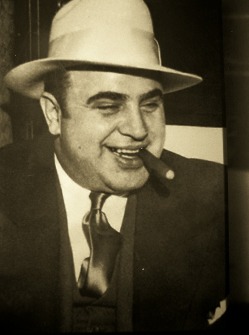Prohibition and Crime

The 18th Amendment was not that effective with keeping alcohol out of the country and away from Americans. With the Volstead Act, the power was given to the government, and hard liquor was abandoned. The government did little at first to enforce the Act, as people would still drink in flasks and water bottles as well as certain states refusing to make laws to enforce the acts and keep alcohol off of the streets. Speakeasies were becoming popular, and they are drinking establishments. Bootleggers were people who smuggled alcohol, and the Federal Prohibition agents were not doing much to stop the people and places violating the 18th Amendment, meant to ban drinking.
The government didn't do much to violators of the Volstead Act, as the act caused people to be more opposed to the law and to prohibition. The local authorities in cities couldn't keep up with the illegal production and distribution of alcohol to the speakeasies in the cities. As the demand for alcohol grew, more and more people began to openly disobey the law, and resulted in a higher crime rate.
The 1920's have a big reputation for gangsters and crime, one of the most notorious gangsters being Al Capone. However, the reputation the 1920's has for being a time period of gangs and violence may be an overstatement. The 20's was a time period of discovery for culture and experimentation for the everyday American. Gangs were a small part of it, but may seem to be a larger part of it due to the world's fascination with crime and violence.
The government didn't do much to violators of the Volstead Act, as the act caused people to be more opposed to the law and to prohibition. The local authorities in cities couldn't keep up with the illegal production and distribution of alcohol to the speakeasies in the cities. As the demand for alcohol grew, more and more people began to openly disobey the law, and resulted in a higher crime rate.
The 1920's have a big reputation for gangsters and crime, one of the most notorious gangsters being Al Capone. However, the reputation the 1920's has for being a time period of gangs and violence may be an overstatement. The 20's was a time period of discovery for culture and experimentation for the everyday American. Gangs were a small part of it, but may seem to be a larger part of it due to the world's fascination with crime and violence.
